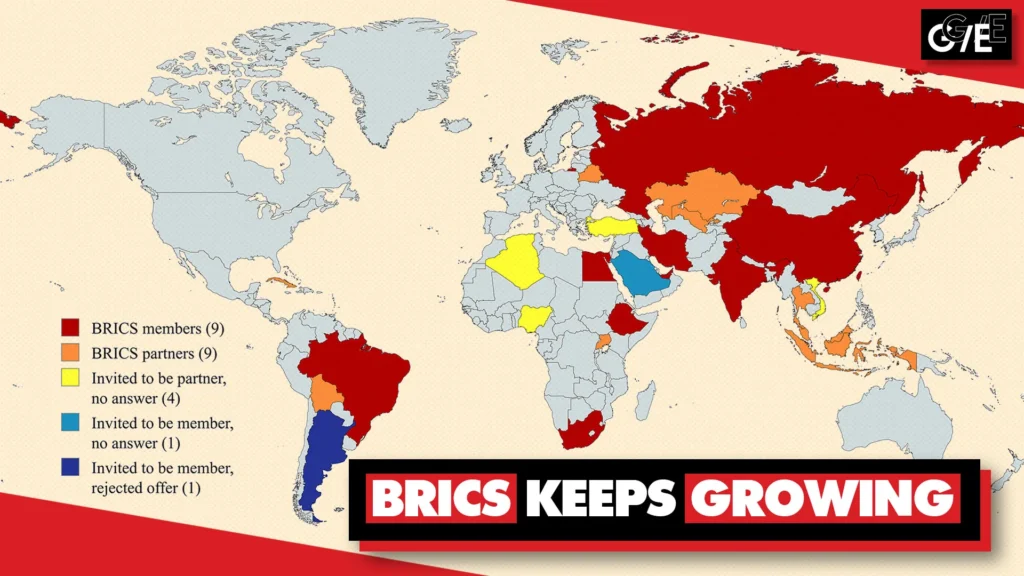BRICS Expands with Nine New Partner Countries
BRICS, 30 Dec 2024
Ben Norton | Geopolitical Economy Report – TRANSCEND Media Service
Now It’s Half of World Population, 41% of Global Economy
25 Dec 2024 – BRICS keeps expanding, adding 9 partner countries in January 2025, after admitting 4 new members in 2024. It now makes up roughly half of the global population and more than 41% of world GDP (PPP). It’s an economic powerhouse, with top producers of key commodities like oil, gas, grains, meat, and minerals.
BRICS, the Global South-led forum for economic cooperation, continues to grow in influence, as its seeks to de-dollarize and transform the international monetary and financial system.
After admitting four new members in 2024, BRICS officially welcomes nine new nations as partner countries on January 1, 2025. They are:
- Belarus
- Bolivia
- Cuba
- Indonesia
- Kazakhstan
- Malaysia
- Thailand
- Uganda
- Uzbekistan
With its nine members and nine partners, BRICS now makes up roughly half of the global population and more than 41% of world GDP (PPP).
The group is an economic powerhouse, including top producers of key commodities like oil, gas, grains, meat, and minerals.
At the BRICS summit in Kazan, Russia in October 2024, 13 countries were invited to become BRICS partners, meaning they are on the path to full membership in the near future.
Nine of these 13 nations accepted the invitation. The remaining four did not give a formal response as of the end of 2024. These were Algeria, Nigeria, Turkey/Türkiye, Vietnam.
The Russian government, which in December announced the admission of the nine new partners, emphasized that “we expect that in the near future responses will come from” the other four.
BRICS: 9 members and 9 partners
Initially founded in 2009 as BRIC – by Brazil, Russia, India, and China – the organization grew in 2010 with the addition of South Africa.
At the 2023 summit in Johannesburg, South Africa, BRICS expanded again, inviting six more countries: Argentina, Egypt, Ethiopia, Iran, Saudi Arabia, and the United Arab Emirates.
Egypt, Ethiopia, Iran, and the UAE accepted the invitation and officially became BRICS members in January 2024.
Saudi Arabia still had not made a formal decision as of the end of 2024.
Argentina initially agreed to join, when it had a center-left government led by President Alberto Fernández and Vice President Cristina Fernández de Kirchner. However, far-right pro-US leader Javier Milei came to power in December 2023, and he overturned the decision, blocking Argentina from joining BRICS in January 2024.

Representatives of the 9 BRICS members at the 2024 summit in Kazan, Russia
BRICS comprises roughly half of world population
With the addition of the partner states, nine of the 20 most populous countries on Earth are now part of BRICS.
Their combined population is approximately 4 billion, or roughly half of the world population.
India is the most populous country on Earth, followed by China in second. Each country has more than 1.4 billion inhabitants.
With nearly 290,000 citizens, Indonesia is the fourth-most populous nation.
Brazil is the seventh-most populous country, followed by Russia in ninth and Ethiopia in tenth.
Egypt is the 14th-most populous nation; Iran is the 17th; and Thailand is the 20th.
The sixth-most populous nation, Nigeria, was invited to join BRICS as a partner, but did not give a formal answer in 2024.

BRICS makes up 41% of global GDP (PPP)
Together, the nine BRICS members and additional nine BRICS partners represent more than 41% of global GDP (when measured at purchasing power parity).
The original five BRICS members made up 33.76% of world GDP (PPP) in October 2024, according to IMF data.

This means that the five founding BRICS members comprise a larger share of the global economy than the G7, which only represented 29.08% of world GDP (PPP) in 2024.
This is a massive decline from 1990, when the G7 economies made up nearly 52% of world GDP (PPP).

The main reason for this historic shift is the enormous economic growth in China, which has become the world’s only industrial superpower, responsible for 35% of global gross manufacturing production (nearly three times that of the United States).
China overtook the US to become the largest economy on Earth in 2016, according to IMF data.
As of October 2024, China made up 19% of global GDP (PPP), compared to just 15% for the US.

When the four new BRICS members that were admitted in 2024 are added, the share of global GDP comprised by BRICS’ nine members rises to 36.44%.

The addition of nine new partner states increases BRICS’ share of world GDP further, to 41.41% (and this does not include Cuba, as the IMF does not have data on the country’s economy).
US GDP overstates its economic power
While GDP can give a rough approximate of the influence of a country in the global economy, the measurement presents its own series of problems. GDP does not necessarily reflect the productive capacities of a nation; it is important to look at the sectoral composition of GDP.
In the United States for instance, a staggering 21% of GDP comes from the FIRE sector: finance, insurance, and real estate. Another 13% of US GDP consists of professional and business services, from white-collar workers like lawyers and managers. Manufacturing makes up only around 10% of US GDP.

Another 8% of US GDP, as reported by the Bureau of Economic Analysis (BEA), is the imputed rental value of owner-occupied housing, or how much an owner of a house would hypothetically pay to rent a house they own and live in. This is to say, 8% of US GDP does not really exist; it is merely accounting.
Furthermore, approximately 18% of US GDP comes from the health sector. The United States spends roughly twice as much on healthcare as the average advanced economy in the OECD, yet has some of the worst public health results.
Just because a country has more expensive services in a given sector, and thus has a higher GDP, doesn’t mean that its people benefit. The case of the US health system is a clear example of how residents can in fact suffer greatly, despite having impressive GDP statistics.

BRICS: a commodities powerhouse, producing grains, meat, oil, gas, minerals
The people of a country can’t eat their GDP. A more useful assessment of BRICS’ growing economic power can be seen in the productive capacities of the economies that make up the organization.
BRICS members and partners are the world’s leaders in the production of crucial commodities, such as cereals, meat, crude oil, natural gas, and strategic minerals like iron ore, copper, and nickel.
The main primary crops in the world, which represent more than half of global agricultural production, are, respectively, sugar cane, maize (corn), rice, wheat, oil palm fruit, and potatoes, according to the UN Food and Agriculture Organization (FAO).
BRICS countries dominate global production of these primary crops.
Brazil, India, and China make up roughly two-thirds of global production of sugar cane.
China and Brazil represent nearly 30% of global maize (corn) production.
China and India produce over half of the world’s rice.
China, India, and Russia produce more than 40% of the world’s wheat.
Indonesia, Malaysia, and Thailand (all new BRICS partners) comprise almost 90% of global oil palm fruit production.
China and India produce nearly 40% of the world’s potatoes.

BRICS countries likewise produce much of the world’s meat.
China and Brazil make up more than 20% of global chicken production.
China produces more than 40% of the world’s pork.
Brazil and China make up more than 20% of global beef production.

China dominates aquaculture production of seafood, making up nearly 60% of global output. Combined with India and Indonesia, they account for more than 70%.

BRICS countries likewise make up more than half of the world’s production of hen eggs. China alone produces 34%.

BRICS is now an energy powerhouse as well.
China is leading the world’s transition to renewable energy. China is building twice as much solar and wind power capacity as the rest of the world combined.

BRICS countries also play a major role in global production of crude oil.
Five of the world’s top 10 producers of crude oil are in BRICS, including Russia (3rd), China (4th), Iran (7th), the UAE (8th), and Brazil (9th).

BRICS nations are important in the global natural gas industry.
Top natural gas producers in BRICS include Russia (2nd), Iran (3rd), China (8th), the UAE (10th), Indonesia (11th), and Malaysia (15th).
(Venezuela, a major producer of oil and gas, was initially offered BRICS membership, but Brazil vetoed the invitation at the 2024 summit in Russia, which caused an international scandal.)

When it comes to strategic minerals, BRICS is, again, highly influential.
BRICS countries are among the world’s leading producers of iron ore, including Brazil (2nd), China (3rd), India (4th), Russia (5th), South Africa (8th), Kazakhstan (9th), and Iran (10th).
When it comes to global copper production, BRICS members are also very important, including China (3rd), Russia (7th), Indonesia (9th), and Kazakhstan (12th).

The admission of Indonesia as a partner likewise means that the world’s only nickel superpower is now part of BRICS, along with other important nickel producers like Russia (3rd), China (7th), Brazil (8th), and Cuba (9th).

What these statistics demonstrate is that BRICS has become one of the most important organizations on Earth, bringing together nations with massive populations, enormous economies, and incredible productive capacities.
If BRICS countries can successfully coordinate and take collective action, they will change the world.
_____________________________________
 Benjamin Norton is an investigative journalist, analyst, writer and filmmaker. He is the founder and editor of Multipolarista and is based in Latin America. His website: BenNorton.com (Publicaciones en español aquí.)
Benjamin Norton is an investigative journalist, analyst, writer and filmmaker. He is the founder and editor of Multipolarista and is based in Latin America. His website: BenNorton.com (Publicaciones en español aquí.)
Go to Original – geopoliticaleconomy.com
Tags: BRICS, BRICS Central Bank, BRICS Currency, BRICS Network University
DISCLAIMER: The statements, views and opinions expressed in pieces republished here are solely those of the authors and do not necessarily represent those of TMS. In accordance with title 17 U.S.C. section 107, this material is distributed without profit to those who have expressed a prior interest in receiving the included information for research and educational purposes. TMS has no affiliation whatsoever with the originator of this article nor is TMS endorsed or sponsored by the originator. “GO TO ORIGINAL” links are provided as a convenience to our readers and allow for verification of authenticity. However, as originating pages are often updated by their originating host sites, the versions posted may not match the versions our readers view when clicking the “GO TO ORIGINAL” links. This site contains copyrighted material the use of which has not always been specifically authorized by the copyright owner. We are making such material available in our efforts to advance understanding of environmental, political, human rights, economic, democracy, scientific, and social justice issues, etc. We believe this constitutes a ‘fair use’ of any such copyrighted material as provided for in section 107 of the US Copyright Law. In accordance with Title 17 U.S.C. Section 107, the material on this site is distributed without profit to those who have expressed a prior interest in receiving the included information for research and educational purposes. For more information go to: http://www.law.cornell.edu/uscode/17/107.shtml. If you wish to use copyrighted material from this site for purposes of your own that go beyond ‘fair use’, you must obtain permission from the copyright owner.
Join the discussion!
We welcome debate and dissent, but personal — ad hominem — attacks (on authors, other users or any individual), abuse and defamatory language will not be tolerated. Nor will we tolerate attempts to deliberately disrupt discussions. We aim to maintain an inviting space to focus on intelligent interactions and debates.

